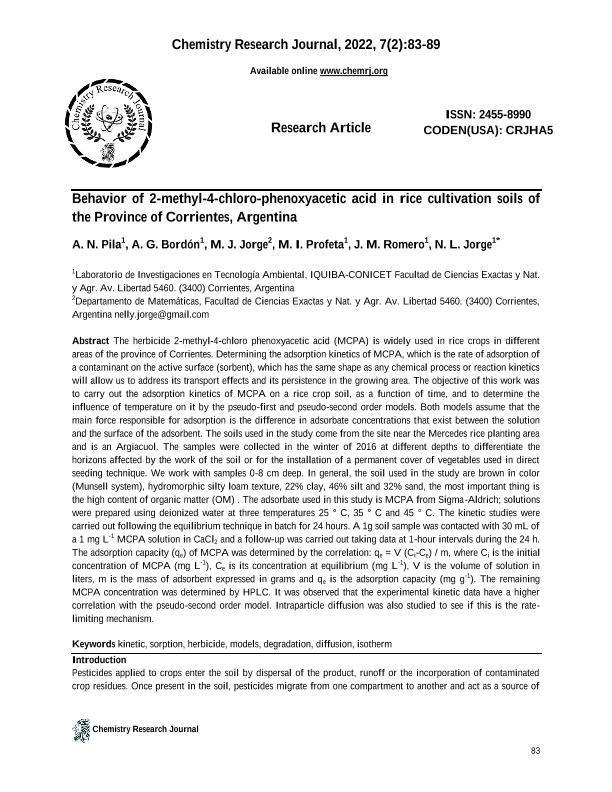Artículo
Behavior of 2-methyl-4-chloro-phenoxyacetic acid in rice cultivation soils of the province of Corrientes, Argentina
Pila, Andrea Natalia ; Bordón, Alexander Germán; Jorge, Maria Josefa; Profeta, Mariela Inés; Romero, Jorge Marcelo; Jorge, Nelly Lidia
; Bordón, Alexander Germán; Jorge, Maria Josefa; Profeta, Mariela Inés; Romero, Jorge Marcelo; Jorge, Nelly Lidia
 ; Bordón, Alexander Germán; Jorge, Maria Josefa; Profeta, Mariela Inés; Romero, Jorge Marcelo; Jorge, Nelly Lidia
; Bordón, Alexander Germán; Jorge, Maria Josefa; Profeta, Mariela Inés; Romero, Jorge Marcelo; Jorge, Nelly Lidia
Fecha de publicación:
05/2022
Editorial:
Chemistry Research Journal
Revista:
Chemistry research journal
ISSN:
2455-8990
Idioma:
Inglés
Tipo de recurso:
Artículo publicado
Clasificación temática:
Resumen
The herbicide 2-methyl-4-chloro phenoxyacetic acid (MCPA) is widely used in rice crops in different areas of the province of Corrientes. Determining the adsorption kinetics of MCPA, which is the rate of adsorption of a contaminant on the active surface (sorbent), which has the same shape as any chemical process or reaction kinetics will allow us to address its transport effects and its persistence in the growing area. The objective of this work was to carry out the adsorption kinetics of MCPA on a rice crop soil, as a function of time, and to determine the influence of temperature on it by the pseudo-first and pseudo-second order models. Both models assume that the main force responsible for adsorption is the difference in adsorbate concentrations that exist between the solution and the surface of the adsorbent. The soils used in the study come from the site near the Mercedes rice planting area and is an Argiacuol. The samples were collected in the winter of 2016 at different depths to differentiate the horizons affected by the work of the soil or for the installation of a permanent cover of vegetables used in direct seeding technique. We work with samples 0-8 cm deep. In general, the soil used in the study are brown in color (Munsell system), hydromorphic silty loam texture, 22% clay, 46% silt and 32% sand, the most important thing is the high content of organic matter (OM) . The adsorbate used in this study is MCPA from Sigma-Aldrich; solutions were prepared using deionized water at three temperatures 25 ° C, 35 ° C and 45 ° C. The kinetic studies were carried out following the equilibrium technique in batch for 24 hours. A 1g soil sample was contacted with 30 mL of a 1 mg L-1 MCPA solution in CaCl2 and a follow-up was carried out taking data at 1-hour intervals during the 24 h. The adsorption capacity (qe) of MCPA was determined by the correlation: qe = V (Ci-Ce) / m, where Ci is the initial concentration of MCPA (mg L-1), Ce is its concentration at equilibrium (mg L-1), V is the volume of solution in liters, m is the mass of adsorbent expressed in grams and qe is the adsorption capacity (mg g-1). The remaining MCPA concentration was determined by HPLC. It was observed that the experimental kinetic data have a higher correlation with the pseudo-second order model. Intraparticle diffusion was also studied to see if this is the ratelimiting mechanism.
Palabras clave:
KINETIC
,
SORPTION
,
HERBICIDE
,
MODELS
,
DEGRADATION
,
DIFFUSION
,
ISOTHERM
Archivos asociados
Licencia
Identificadores
Colecciones
Articulos(IMIT)
Articulos de INST.DE MODELADO E INNOVACION TECNOLOGICA
Articulos de INST.DE MODELADO E INNOVACION TECNOLOGICA
Citación
Pila, Andrea Natalia; Bordón, Alexander Germán; Jorge, Maria Josefa; Profeta, Mariela Inés; Romero, Jorge Marcelo; et al.; Behavior of 2-methyl-4-chloro-phenoxyacetic acid in rice cultivation soils of the province of Corrientes, Argentina; Chemistry Research Journal; Chemistry research journal; 7; 2; 5-2022; 83-89
Compartir



